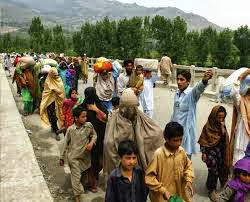It is not for the dead that the bell tolls,
but for those who are left behind.
October 22, 2013Civilian Deaths in Drone Strikes Cited in Report
By DECLAN WALSH and IHSANULLAH TIPU MEHSUD
LONDON — In the telling of some American officials, the C.I.A. drone campaign in Pakistan has been a triumph with few downsides: In more than 300 missile attacks there since 2008, dozens of Qaeda and Taliban leaders have been killed, and the pace of the strikes, which officials frequently describe as “surgical” and “contained,” has dropped sharply over the past year.
But viewed from Miram Shah, the frontier Pakistani town that has become a virtual test laboratory for drone warfare, the campaign has not been the antiseptic salve portrayed in Washington. . . .
“The drones are like the angels of death,” said Nazeer Gul, a shopkeeper in Miram Shah. “Only they know when and where they will strike.”
Their claims of distress are now being backed by a new Amnesty International investigation that found, among other points, that at least 19 civilians in the surrounding area of North Waziristan had been killed in just two of the drone attacks since January 2012 — a time when the Obama administration has held that strikes have been increasingly accurate and free of mistakes.
The study is to be officially released on Tuesday along with a separate Human Rights Watch report on American drone strikes in Yemen, as the issue is again surfacing on other fronts. On Wednesday, Prime Minister Nawaz Sharif, a vocal critic of the drone campaign, is to meet with President Obama in the White House. . . .
But nowhere has the issue played out more directly than in Miram Shah, in northwestern Pakistan. It has become a fearful and paranoid town, dealt at least 13 drone strikes since 2008, with an additional 25 in adjoining districts — more than any other urban settlement in the world.
Even when the missiles do not strike, buzzing drones hover day and night, scanning the alleys and markets with roving high-resolution cameras.
That is because their potential quarry is everywhere in Miram Shah — Islamist fighters with long hair, basketball shoes and AK-47 rifles who roam the streets, fraternize in restaurants and, in some cases, even direct traffic in the central bazaar. The men come from an array of militant groups that take shelter in Waziristan and nearby, including Al Qaeda and the Afghan and Pakistani Taliban. . . .
Unusually for the overall American drone campaign, the strikes in the area mostly occur in densely populated neighborhoods. The drones have hit a bakery, a disused girls’ school and a money changers’ market, residents say. . . .
While the strike rate has dropped drastically in recent months, the constant presence of circling drones — and accompanying tension over when, or whom, they will strike — is a crushing psychological burden for many residents.
Sales of sleeping tablets, antidepressants and medicine to treat anxiety have soared, said Hajji Gulab Jan Dawar, a pharmacist in the town bazaar. Women were particularly troubled, he said, but men also experienced problems. “We sell them this,” he said, producing a packet of pills that purported to treat erectile dysfunction under the brand name Rocket.
Despite everything, a semblance of normal life continues in Miram Shah. On market day, farmers herding goats and carrying vegetables stream in from the surrounding countryside.. . . On the edge of town, where buildings melt into low, tree-studded hills, young boys play soccer on the banks of the Tochi River. As in so many other countries, some youngsters wear the jersey of the English soccer club Manchester United. . . .
But the new Amnesty International report, which examines the 45 known strikes in North Waziristan between January 2012 and August 2013, asserts that in several cases drones killed civilians indiscriminately.
Last October, it says, American missiles killed a 68-year-old woman named Mamana Bibi as she picked vegetables in a field close to her grandchildren. In July 2012, 18 laborers, including a 14-year-old boy, were killed near the Afghan border.Ms. Bibi’s son, Rafiq ur-Rehman, and two of her injured grandchildren are due to travel to the United States next week to speak about their experiences.
“The killing of Mamana Bibi appears to be a clear case of extrajudicial execution,” said Mustafa Qadri, the report’s author, in an interview. “It is extremely difficult to se
e how she could have been mistaken for a militant, let alone an imminent threat to the U.S.”
Declan Walsh reported from London, and Ihsanullah Tipu Mehsud from Miram Shah, Pakistan. Zia ur-Rehman contributed reporting from Karachi, Pakistan.
∼ ∼ ∼
Drone strikes are not like baseball strikes: they carry a pretty big punch.
Daily life in Miran Shah
Carrying goods to market
Manchester United is a favorite team
North Waziristani like their open carry laws . . .
. . . as do some Texans.




+Desroyd+By+Shelling.jpg)












No comments:
Post a Comment